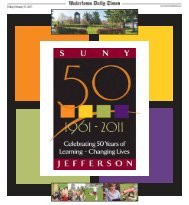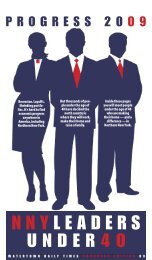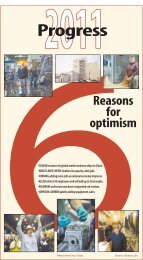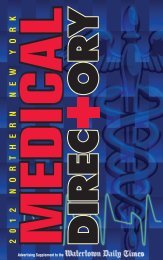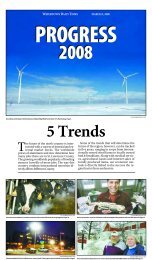Thursday, September 22, 2011 - Watertown Daily Times
Thursday, September 22, 2011 - Watertown Daily Times
Thursday, September 22, 2011 - Watertown Daily Times
You also want an ePaper? Increase the reach of your titles
YUMPU automatically turns print PDFs into web optimized ePapers that Google loves.
C M Y K• 1 50 th A N N I VE R SAR Y • 18 6 1 - 2 0 1 1 •E10 <strong>Thursday</strong>, <strong>September</strong> <strong>22</strong>, <strong>2011</strong>WATERTOWN DAILY TIMESW A T E R T O W N1861 <strong>2011</strong>J OIN US FO R T H E N EXT 1 5 0 Y E A R SWD A I LY T I M E SStaffers have worked at major publications, written booksGordon W. BryantAs the 1916, city editor HaroldB. Johnson asked <strong>Watertown</strong> HighSchool to send him a senior who wasalert, energetic and a good scholarto be an office boy. Thus began a careerat the <strong>Times</strong> for Gordon Bryantthat spanned six decades as reporter,sports editor, telegraph editor, city editorand finally executive editor. Evenin retirement, he was kept in the company’sfold as consultant. A demandingboss, he was described by one ofhis former subordinants in a WashingtonPost story as having “the temperof a hibernating bear whose cavehas been broken into, and just underthe surface, a heart of pure caramel.”He was 84 when he died in June 1984.Leonard L. aLLenBeman Brockway wanted a marketeditor for his newspaper, so he approachedan experienced farmer whohad done reporting for him about theJefferson County Teachers Association.Leonard Allen, a <strong>Watertown</strong> HighSchool graduate, stepped into the rolein February 1894, about 14 months afterMr. Brockway’s death.A significant part of his job wasmonitoring <strong>Watertown</strong>’s interiorcheese market, which at the time wasthe largest in the world, with annualsales of nearly $2 million through the<strong>Watertown</strong> Produce Exchange. In a13-year stint at the <strong>Times</strong>, he moved toagriculture editor and then city editor.While in that post, he brought HaroldB. Johnson onto the newspaper’s staff.In 1933 he published his “History ofthe New York State Grange.” He was89 when he died on Dec. 5, 1949.Frank P. AugustineHis career spanned 38 years as reporter,telegraph editor, state editor,assistant city editor, news editor, editorof the editorial page and politicalwriter. He, along with John B. Johnson,publisher, and Alan S. Emory,Washington correspondent, won In1967 the national Thomas L. Stokesjournalism award for editorials andnews stories in a successful campaignagainst a plan to exclude the PowerAuthority of the State of New Yorkfrom participating in the developmentof nuclear power. Mr. Augustine,who retired in 1979, authored “LaBella America: From the Old Countryto the North Country,” published in1989 by the <strong>Times</strong>. An Albany Countynative, he died at the age of 86 on Dec.<strong>22</strong>, 2002.John G. CaseThe sports editor of the <strong>Watertown</strong><strong>Daily</strong> <strong>Times</strong> interviewed some of thebiggest names in sports of his era. TheJack Case by-line appeared above hisaccounts from visits with Lou Gehrig,Roy Campanella, Walter Hagen,Maxie Rosenbloom, Joe Louis, MaxBaer, Carmen Basilio, and the fighterwho he was credited with nicknaming,Sugar Ray Robinson. After watchingRobinson in the ring, he told theyoung fighter’s manager, “That’s asweet boy you have there,” to whichthe manager replied, “sweet as sugar.”Case’s column the next day introduced“Sugar Ray” to his readers.Jack Case joined the staff in 1920and became sports editor in 1929.He was on the Heisman Memorialtrophy committee for nearly three decades,and a guest slot on Red Barber’sGordon Bryant in the WDT newsroom.Sports on CBS radio. He also voicedsports reports on WWNY radio, operatedby the <strong>Times</strong>.He retired in 1971, and was 71 whenhe died in May 1973.Jesse CottreLLJesse Cottrell, who was born inKnoxville, Tenn., in 1878, was a Washingtonreporter for the <strong>Times</strong>. DuringWorld War I, he was a captain inmilitary intelligence. He later servedas President Warren Harding’s ministerto Bolivia and President CalvinCoolidge’s special ambassador to Bolivia.At the age of 58, he resumed filingnews stories for the <strong>Times</strong>, from 1936until he died in 1944.Alan EmoryAlan S. Emorywas the longestservingWashingtoncorrespondentfor any newspaperin America. He covered10 presidentialadministrations,Emory beginning withHarry S. Truman. In1959 he saw Vice President Richard M.Nixon’s “kitchen debate” with SovietPremier Nikita S. Khrushchev in Moscow,and covered Mr. Nixon’s talksin 1972 with Soviet leader Leonid I.Brezhnev that developed agreementsin limiting the production of nuclearweapons. He began with the <strong>Times</strong> in1947. He was assigned to the <strong>Times</strong>’Washington bureau in 1951. He andcolleague Frank P. Augustine won the1967 Thomas L. Stokes Award, andwas a president of the WashingtonProfessional Chapter, Society of ProfessionalJournalists, Sigma Delta Chi.He was inducted into that society’shall of fame in 1979. He died at 78 onNov. 27, 2000.Jay JochnowitzA series of editorialson “New York’sHall of Shame,”highlighting howtop legislative leadersand local lawmakerscontributedto gridlockJochnowitzsurrounding the2009 coup in thestate senate earned for Jay Jochnowitz,editorial page editor of the Albany<strong>Times</strong> Union, first prize recognitionfrom the New York State AssociatedPress Association. Mr. Jochnowitz was27 when he came to the <strong>Watertown</strong><strong>Times</strong> in 1984. One of his early dutieswas to cover the visit of Pope JohnPaul in Ottawa. He joined the Albany<strong>Times</strong> Union 1987. He later becamestate editor and in 2008 was givencharge of editorials.Michael J. Kernan Jr.Utica native Mike Kernan brokeinto journalism with the <strong>Times</strong> in1949, and remained here four years.He moved to California for a 13-yearstay, during which he received a firstplaceaward for reporting from theCalifornia-Nevada branch of AssociatedPress. Mr. Kernan in 1967 begana 23-year run as feature reporter withthe Washington Post, where his contributionsincluded profiles of Gen.Maxwell Taylor, Jack Benny, VolkerSchlondorff, Gene Kelly and RichardDreyfuss. After winning first prize in a1975 London <strong>Times</strong> ghost story contestfor “The Doll Named Silvio,” ashort story, Mr. Kernan authored twonovels, “The Violet Dots,” in 1977,and “The Lost Diaries of Frans Hals”in 1994, which was translated intoFrench, German and Dutch.He died May 4, 2005, at Bennington,Vt., at the age of 78.Margaret KissingerMeg Kissingerwas a general assignmentreporterwith the <strong>Times</strong> fromJune 1979 to January1981. She movedto the CincinnatiPost before settlingin Milwaukeein 1983. A 2009 investigationthat sheKissingerand a colleague conducted resultedin a six-part series that revealed a governmentalfailure in protecting thepublic from dangerous chemicals ineveryday products, such as some “microwave-safe”containers. They citedfailures by the federal EnvironmentalProtection Agency and the Food andDrug Administration. The 2009 serieswon for the pair a George Polk Award,a National Journalism Award for EnvironmentalReporting and Public Service,and was a finalist for the PulitzerAward for investigative reporting.Harry F. LandonHarry Landon authored four booksbetween 1932 and 1954: “The NorthCountry, A History,” “An ElementaryHistory of Northern New York,” “150Years of <strong>Watertown</strong>,” and “Bugles onthe Border.” He was considered theforemost authority on the early historyof Northern New York.In 1917, he was hired as secretary toCongressman Luther W. Mott. He leftthat position to sign on with the Armymedical corps during World War I,and then attended Washington Collegeto obtain a law degree.Mr. Landon returned in 1923,where over the next 31 years he wouldfill posts of political writer; state editor,city editor and managing editor.In his latter role, “for five years heprovided the assistance that made itpossible for an orderly transition inmanagement” after Harold Johnsondied, wrote John B. Johnson. A seriesof historical stories he wrote in 1950for the <strong>Times</strong> won an award from theNew York State Historical Association.Mr. Landon died at 62 on Nov. 6,1954..John Reed CostonJohn Coston came to the <strong>Times</strong> in1971 and was assigned the City Hallbeat. He subsequently moved onto the Hartford Courant, the MiamiHarold, and ultimately to the WallStreet Journal, where he is newseditor on the national desk. Mr.Coston’s book “To Kill and Kill Again,”published in 1992, was nominated forthe Edgar Allan Poe Mystery Prize, andhe also authored “Sleep, My Child,Forever,” published in 1995.Ken LovettKen Lovett is Albanybureau chieffor the New York<strong>Daily</strong> News, and inMay 2010 the WalterT. Brown LegislativeCorrespondentAlumni AssociationAward for excellencein reportingLovetton state government. He was cited forhis coverage of the state pension fundscandal. His work in Albany has alsobrought him honors from the NewYork News Publishers Association andAssociated Press.Mr. Lovett was the <strong>Times</strong>’ City Hallreporter from June 1988 to October1992. After a series of jobs at other papers,he returned to Albany in January2000 as correspondent for the NewYork Post. He has been with the <strong>Daily</strong>News since April 2008.“There isn’t a day I don’t find myselfusing the skills I first honed at the<strong>Watertown</strong> <strong>Times</strong>,” he recently wrote.“And I’ve always said, the Johnsonsare among the most dedicated newspeople I’ve worked for. They didn’tcare about going to war with City Hallor anyone else. They cared about gettingand reporting stories, both bigand small, and providing blanket coverageto the community.”James A. “Jay” MooreWith a telephone call on June 21,1919, to Napanee, Ontario, Jay Mooreinterviewed an escapee from Clintonprison, then typed out William Ellis’admission about a burglary he committedafter his prison break. His“scoop” filed, the reporter got up fromhis desk, announced, “I’m going outand get something to eat,” and neverreturned to the <strong>Times</strong> office on ArcadeStreet. Early the next morning, Sunday,as the 36-year-old reporter wasreturning with a <strong>Watertown</strong> policemanfrom a fatal accident in the townof Rutland, their auto overturned. Hewas pinned beneath the car, later todie of his injuries in a hospital, becomingthe only <strong>Times</strong> reporter known tohave been killed on the job. Survivorsincluded his wife and two children,ages 14 and 10.His employment with the <strong>Times</strong>began when he was 10, as a carrier. Mr.Moore eventually worked in the mailingdepartment, where the city editorapproached and asked if he would liketo cover sports events. He was soonthe “sporting editor” and developed asports page. In that role, he attendedand reported on the 1917 World Series.Finally, he was given the policebeat, where, according to an editorialat the time of his death, “he wasabsolutely tireless in his energy” and“he would never permit an obstacle tostand in the way of his accomplishinghis purpose in getting a story.”PickertDominic PePPIn a career that spanned 43 years,“Dom” Pepp covered the expansionof Pine Camp to Camp Drum and FortDrum, and had interviews with EleanorRoosevelt, Lawrence Welk andsinger Kate Smith. He was the onlyreporter present in 1955 when a sixdaymanhunt of three escapees fromSt. Lawrence County Jail ended with ashootout. He opened his May 2 storyfrom Hopkinton, “A rain of police bulletstoday ended the life of Frank P.(The Hook) Talarico, 44, and wounded,perhaps mortally, his co-desperado,Ralph F. Lasomb, 28.”The one story he failed to write waswhen he got tossed out of a congressman’shouse while trying to interviewHerbert Hoover.He died at the age of 94 in August2010 in Florida.KATE PICkertMs. Pickert is astaff writer for TIMEmagazine, but hercareer began in 2001in the <strong>Times</strong>’ Carthagebureau.“I loved everyminute of it. Ilearned the importanceof local journalism,how a story in a local newspapercan have far more impact onpeoples’ day to day lives than a longformstory in a glossy national magazine.”“In March 2008, I wrote small blurbsfor the front of the magazine and forTime.com. Less than a year after Istarted, however, I was promoted tostaff writer and assigned to cover thehealth care beat. I covered the entirereform debate, learned an incredibleamount about how Congress worksand tried not to become completelycynical about politics. It wasn’t easy.”beulah rectorBennett Cerf, publisher and cofounderof Random House, wrote inthe Sept. <strong>22</strong>, 1951 issue of SaturdayReview of Literature that “one of bestliterary editors in the country” wasBeulah Rector. She was at the timein her <strong>22</strong>nd year at the <strong>Times</strong>. Shebelieved in quality writing and cleanstories, and if a book measured up tothose two standards, it was bound toreceive a good review.Miss Rector also wrote editorialsand shared her world travel experienceswith <strong>Times</strong>’ readers.Born in Newport, R.I. in 1885, her19<strong>22</strong> arrival in <strong>Watertown</strong> was as organizerof an education departmentat the YWCA. She began a 25-year careerat the <strong>Times</strong> in 1929. Miss Rectorretired in Massachusetts, where shedied in November 1977.Royal K. FuLLerHermon native Royal Fuller wasabout 24 when in 1897 he joined the<strong>Times</strong>. After five years, he moved toNew York City. As reporter with NewYork Herald, he went to the Arctic in1909 and met with Rear Admiral RobertE. Peary. He also covered the Titanictragedy in 1912 for the Herald,and in 1910-1911, he was assigned toaccompany President Howard Taft intravels, and with Taft saw the grounddigging for the Panama-Pacific Exposition.He was 62 when he died Sept. 14,1935.RECOLLECtionReporter met bride in city roomBy TIM BUCKLANDNEW HAMPSHIRE UNION LEADERLike anyone who spendsseven years at any job, I have aton of memories frommy years as a <strong>Times</strong>reporter, nearly all ofthem good.While coveringFort Drum, I rode inBlackhawk helicoptersand (attemptedto) drive a tank. Ispent 10 eye-openingdays reporting the10th Mountain Division’sefforts in war-torn Bosnia-Herzegovina.That timeincluded interviewing a familyof refugees who thought theywere lucky because they founda house that, despite missingtwo walls, had a roof and workingelectricity.I once had a female soldiersob in my office as sheBucklanddetailed her allegations ofsexual harassment at thehands of her supervisor. Shewas especially saddenedbecause she said nobodyin the Armyranks believed her.Four months afterthat story appeared inthe <strong>Watertown</strong> <strong>Daily</strong><strong>Times</strong>, that supervisor,who had steadfastlymaintained hisi n n o c e n c e d u r i n ginterviews with me,confessed his guilt toavoid a court-martial.I was standing in thenewsroom on Sept. 11, 2001,crowded at a 13-inch televisionwith 30 other peoplewatching the events of thatday in horror.As the city hall reporter, Ionce had Mayor Jeff Grahamso mad at me that he spent 10minutes in an open meetingberating me and questioningmy professionalism.I made friends who I stillkeep in touch with today.While all of those moments,and many more, kept my jobinteresting at all times, it palesin comparison to the fall of2003, when I met the new educationreporter, Kate DeForest.I would marry Kate two yearslater and we now have a 2-yearoldboy.After a five-year hiatus, I’mback in journalism at the NewHampshire Union Leader inManchester, N.H. I’m makingpeople mad again by demandinginformation thatthe public needs to knowabout.But I will always look backwith fondness when I remembermy time at the <strong>Watertown</strong><strong>Daily</strong> <strong>Times</strong>.







